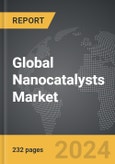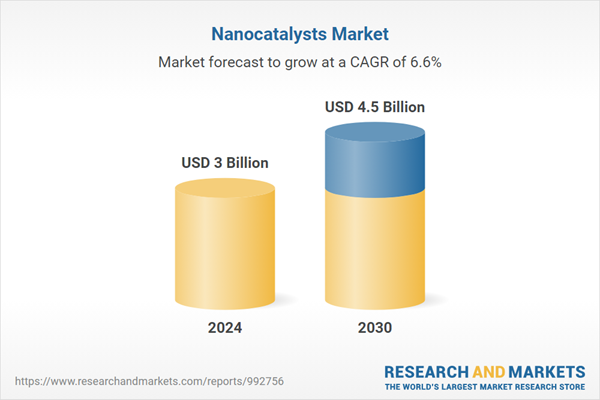The global market for Nanocatalysts was valued at US$3.0 Billion in 2024 and is projected to reach US$4.5 Billion by 2030, growing at a CAGR of 6.6% from 2024 to 2030. This comprehensive report provides an in-depth analysis of market trends, drivers, and forecasts, helping you make informed business decisions. The report includes the most recent global tariff developments and how they impact the Nanocatalysts market.
The development of nanocatalysts is driven by advancements in nanotechnology and materials science. Researchers are continually exploring new methods to synthesize and characterize nanocatalysts with improved properties, such as increased stability, selectivity, and reusability. Techniques such as sol-gel processing, chemical vapor deposition, and electrochemical methods are employed to create nanocatalysts with precise control over their size, shape, and composition. Additionally, the incorporation of nanocatalysts into various reaction systems is being optimized to maximize their performance and minimize potential environmental impacts.
The growth in the nanocatalysts market is driven by several factors. Firstly, the increasing demand for efficient and sustainable chemical processes is a major driver, as nanocatalysts offer superior catalytic performance. Secondly, advancements in nanotechnology and synthesis techniques are enabling the development of high-performance nanocatalysts with tailored properties. Thirdly, the growing focus on environmental sustainability and the need for effective pollution control measures are boosting the adoption of nanocatalysts in environmental remediation applications. Additionally, the rise in energy production activities, such as hydrogen generation and fuel cell technology, is driving the demand for nanocatalysts. Furthermore, the expanding pharmaceutical industry and the need for efficient drug synthesis are contributing to market growth. Lastly, the increasing investment in research and development by both academic institutions and industrial players is supporting the advancement and commercialization of nanocatalysts.
Segments: Application (Refinery & Petrochemical, Environment, Food Processing, Chemical Synthesis, Other Applications).
Geographic Regions/Countries: World; USA; Canada; Japan; China; Europe; France; Germany; Italy; UK; Rest of Europe; Asia-Pacific; Rest of World.
The analysts continuously track trade developments worldwide, drawing insights from leading global economists and over 200 industry and policy institutions, including think tanks, trade organizations, and national economic advisory bodies. This intelligence is integrated into forecasting models to provide timely, data-driven analysis of emerging risks and opportunities.
Global Nanocatalysts Market - Key Trends & Drivers Summarized
Nanocatalysts are a class of catalysts that operate at the nanoscale, typically ranging from 1 to 100 nanometers in size. These catalysts are characterized by their high surface area-to-volume ratio, which enhances their catalytic activity and efficiency compared to conventional catalysts. Nanocatalysts are used in various applications, including chemical synthesis, environmental remediation, energy production, and pharmaceutical manufacturing. Their ability to facilitate faster and more efficient chemical reactions makes them valuable in processes such as hydrogen production, carbon capture, and pollutant degradation.The development of nanocatalysts is driven by advancements in nanotechnology and materials science. Researchers are continually exploring new methods to synthesize and characterize nanocatalysts with improved properties, such as increased stability, selectivity, and reusability. Techniques such as sol-gel processing, chemical vapor deposition, and electrochemical methods are employed to create nanocatalysts with precise control over their size, shape, and composition. Additionally, the incorporation of nanocatalysts into various reaction systems is being optimized to maximize their performance and minimize potential environmental impacts.
The growth in the nanocatalysts market is driven by several factors. Firstly, the increasing demand for efficient and sustainable chemical processes is a major driver, as nanocatalysts offer superior catalytic performance. Secondly, advancements in nanotechnology and synthesis techniques are enabling the development of high-performance nanocatalysts with tailored properties. Thirdly, the growing focus on environmental sustainability and the need for effective pollution control measures are boosting the adoption of nanocatalysts in environmental remediation applications. Additionally, the rise in energy production activities, such as hydrogen generation and fuel cell technology, is driving the demand for nanocatalysts. Furthermore, the expanding pharmaceutical industry and the need for efficient drug synthesis are contributing to market growth. Lastly, the increasing investment in research and development by both academic institutions and industrial players is supporting the advancement and commercialization of nanocatalysts.
Report Scope
The report analyzes the Nanocatalysts market, presented in terms of units. The analysis covers the key segments and geographic regions outlined below.Segments: Application (Refinery & Petrochemical, Environment, Food Processing, Chemical Synthesis, Other Applications).
Geographic Regions/Countries: World; USA; Canada; Japan; China; Europe; France; Germany; Italy; UK; Rest of Europe; Asia-Pacific; Rest of World.
Key Insights:
- Market Growth: Understand the significant growth trajectory of the Refinery & Petrochemicals segment, which is expected to reach US$1.8 Billion by 2030 with a CAGR of a 6.9%. The Environment segment is also set to grow at 7.8% CAGR over the analysis period.
- Regional Analysis: Gain insights into the U.S. market, valued at $682.2 Million in 2024, and China, forecasted to grow at an impressive 7.8% CAGR to reach $528.2 Million by 2030. Discover growth trends in other key regions, including Japan, Canada, Germany, and the Asia-Pacific.
Why You Should Buy This Report:
- Detailed Market Analysis: Access a thorough analysis of the Global Nanocatalysts Market, covering all major geographic regions and market segments.
- Competitive Insights: Get an overview of the competitive landscape, including the market presence of major players across different geographies.
- Future Trends and Drivers: Understand the key trends and drivers shaping the future of the Global Nanocatalysts Market.
- Actionable Insights: Benefit from actionable insights that can help you identify new revenue opportunities and make strategic business decisions.
Key Questions Answered:
- How is the Global Nanocatalysts Market expected to evolve by 2030?
- What are the main drivers and restraints affecting the market?
- Which market segments will grow the most over the forecast period?
- How will market shares for different regions and segments change by 2030?
- Who are the leading players in the market, and what are their prospects?
Report Features:
- Comprehensive Market Data: Independent analysis of annual sales and market forecasts in US$ Million from 2024 to 2030.
- In-Depth Regional Analysis: Detailed insights into key markets, including the U.S., China, Japan, Canada, Europe, Asia-Pacific, Latin America, Middle East, and Africa.
- Company Profiles: Coverage of players such as BASF SE, Dow, Inc., Evonik Industries AG, Johnson Matthey Plc, Kronos Worldwide, Inc. and more.
- Complimentary Updates: Receive free report updates for one year to keep you informed of the latest market developments.
Some of the 55 companies featured in this Nanocatalysts market report include:
- BASF SE
- Dow, Inc.
- Evonik Industries AG
- Johnson Matthey Plc
- Kronos Worldwide, Inc.
- Nexceris
- PQ Corporation
- TitanPE Technologies, Inc.
- Umicore N.V.
- Venator Materials PLC
- W. R. Grace & Co.
- Zeolyst International
Tariff Impact Analysis: Key Insights for 2025
Global tariff negotiations across 180+ countries are reshaping supply chains, costs, and competitiveness. This report reflects the latest developments as of April 2025 and incorporates forward-looking insights into the market outlook.The analysts continuously track trade developments worldwide, drawing insights from leading global economists and over 200 industry and policy institutions, including think tanks, trade organizations, and national economic advisory bodies. This intelligence is integrated into forecasting models to provide timely, data-driven analysis of emerging risks and opportunities.
What’s Included in This Edition:
- Tariff-adjusted market forecasts by region and segment
- Analysis of cost and supply chain implications by sourcing and trade exposure
- Strategic insights into geographic shifts
Buyers receive a free July 2025 update with:
- Finalized tariff impacts and new trade agreement effects
- Updated projections reflecting global sourcing and cost shifts
- Expanded country-specific coverage across the industry
Table of Contents
I. METHODOLOGYII. EXECUTIVE SUMMARY2. FOCUS ON SELECT PLAYERSIII. MARKET ANALYSISIV. COMPETITION
1. MARKET OVERVIEW
3. MARKET TRENDS & DRIVERS
4. GLOBAL MARKET PERSPECTIVE
UNITED STATES
CANADA
JAPAN
CHINA
EUROPE
FRANCE
GERMANY
ITALY
UNITED KINGDOM
REST OF EUROPE
ASIA-PACIFIC
REST OF WORLD
Companies Mentioned (Partial List)
A selection of companies mentioned in this report includes, but is not limited to:
- BASF SE
- Dow, Inc.
- Evonik Industries AG
- Johnson Matthey Plc
- Kronos Worldwide, Inc.
- Nexceris
- PQ Corporation
- TitanPE Technologies, Inc.
- Umicore N.V.
- Venator Materials PLC
- W. R. Grace & Co.
- Zeolyst International
Table Information
| Report Attribute | Details |
|---|---|
| No. of Pages | 232 |
| Published | April 2025 |
| Forecast Period | 2024 - 2030 |
| Estimated Market Value ( USD | $ 3 Billion |
| Forecasted Market Value ( USD | $ 4.5 Billion |
| Compound Annual Growth Rate | 6.6% |
| Regions Covered | Global |









